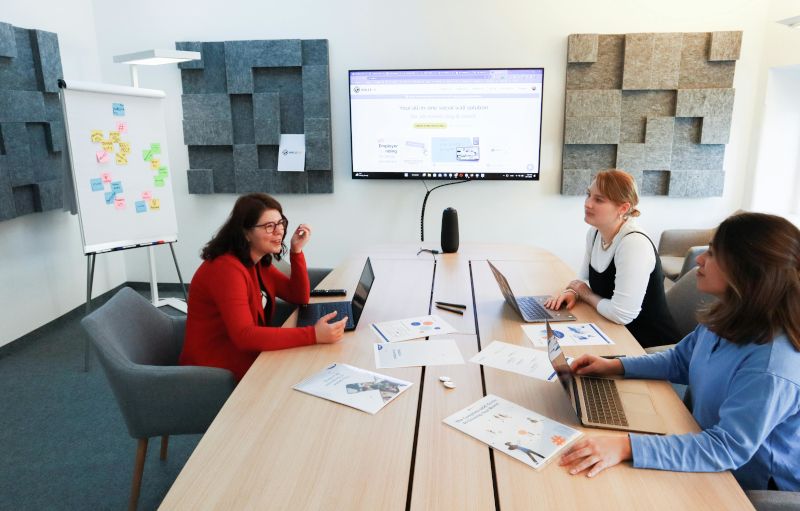Conventions, conferences, and trade shows are essential events for hundreds of industries. Without these gatherings, many companies can’t make the connections they need to grow and expand.
Whether you’re connecting suppliers with retailers or helping industry experts share their knowledge, you have a big job on your hands executing this level of event planning.
The run of show goes beyond just a basic schedule of events. Building a proper run of show (ROS) document takes a few hours, but it pays off for the entirety of the event. These documents can range from a single page for a speaking event to a multi-page document for weekend and week-long conferences.
Make sure you’ve covered all of the bases for your event planning ROS document with this guide.
What is a Run of Show?
The run of show is an advanced type of schedule or agenda. It includes everything significant occurring during the event, including any planned talks, networking opportunities, demonstrations, set-up and take-down times, and other parts of a conference or trade show.
Every minute will be covered, even if the total time is broken down into hours or other blocks of time. It needs to be clearly written and laid out so everyone participating in the planning and execution of the event can read it at a glance.
Many event planners also maintain this document in real time as a master plan for the event that anyone can check as needed for the final word.
Why Do You Need a Run of Show for an Event?
Setting up an in-depth ROS is the first step in highlighting any conflicts and timing issues in your schedule. It’s a visual tool that makes it easier to communicate across teams about goals and limitations for blocks of time throughout the event.
When you’re planning a trade show with hundreds of exhibitors, just managing the set-up and take-down processes can involve a crew of a dozen or more. The ROS serves as the single-source document that keeps everyone on the same page when planning and producing the event.
Without an official source for the finalized schedule, it’s possible that some parts of the event could fall behind or run ahead of the rest. A dynamic ROS works best for this reason. It’s easily updated as needed if conditions or participants change.
What Should Be in Your Run of Show
Writing up a run of show is fairly simple if you take it step by step. Having a basic schedule set for the event first helps, but it’s not necessary if you’re willing to update the ROS as needed.
Using a software solution dedicated to event planning can make this as easy as possible. Writing out the ROS in a spreadsheet software can take twice as long as you must manually set up the layout. No matter the method you use, the basic steps are the same for almost every kind of event ROS.
Contact List
Start out with a contact list for all the essential staff and leadership members for the event. Include email addresses and phone numbers for anyone speaking or presenting at the conference as well.
For an extended ROS, you may want to include another contact list for all exhibitors. Make sure to distribute this contact list to the whole event planning team, including most of the people listed.
This part of the ROS needs to be updated the most if there is any change in the lineup of the event planning crew, leadership, or presenters at the last minute.
Event Flow and Timeline
The bulk of the ROS covers the event’s timeline. This should be a visual representation of the event flow broken down into units of time that make sense for the scale.
For example, you may want to divide a one-day event into 15-minute slots. A week-long event is best broken down into hourly or multi-hour units. Include clearly marked slots of time for speakers, breakout sessions, and anything else scheduled during the event.
The start and stop times for each event need to be written out. Don’t rely just on the visual markers of time to keep everyone on schedule with the run of show.
Event Speaker Details
Listing the start and stop times for each speaker is only part of what goes into the ROS. You also need plenty of details on each speaker or presenter. Include the topic of the talk, the technical needs for their presentation, the total duration of each stage, and specific crew members assigned to that part of the event.
This block of time also needs to include transition times so the presenter has time to get on and off the stage. Make sure to outline any specific audio and visual requirements for the presentation so the crew knows what to set up for each part of the schedule.
Technical Considerations
Speaking of technical considerations, the run of show also has to outline the requirements for lighting, sound, and more during every part of the event.
That includes during speakers or presentations, but it also covers open exhibition hours and background music for networking lunches or breakout events.
Even the set-up and breakdown times for different kinds of technical equipment also need to be covered in the ROS. If a speaker will be using certain projection screens, need timed music, or have slides to display, note that in the ROS as well.
Set-Up & Tear-Down Considerations
Conferences and trade shows with exhibitors need more time in the schedule for setup and tear down than short events with only presenters. Still, the ROS needs to reflect any time needed for arranging equipment and putting it away at the end.
Set-up and tear-down time can stretch for hours if it involves multiple exhibitors in a large hall, or they may only take 10 minutes at the beginning and end of the day. Take into consideration any venue limitations that could slow down or limit these stages of the event.
You can’t expect everyone to break down their displays and transport them out in 10 minutes if they’re presenting in an area with limited access.
Run Of Show Best Practices
Of course, you need to go beyond the basics to create a run of show document that streamlines the event as much as possible. Event planning relies heavily on the planning part, and the ROS is the key physical document of it.
Yet you don’t want to add too much and clutter up the ROS either. Use these tips to ensure you’re creating the best document possible and keeping it up to date as the event evolves and changes.
Gather and Share Information with Stakeholders
Choose a way of publishing the run of show document that allows for constant updates as needed. All stakeholders should always be able to access the ROS and only see the latest information at first. While it’s a smart idea to keep backups of former versions, you can’t have outdated copies confusing crew members or event leaders. Relying on printed copies will only lead to issues when they go out of date.
Color-Code Every Detail
Color-coding is the single most valuable trick for making the run of show as useful as possible as a visual schedule. It’s much easier to scan blocks of time and determine a starting point or an ending time when each block has a different color.
If there are so many blocks of time that they can’t all have unique colors, at least alternate between sections so they’re easy to distinguish from each other. Try color-coding the time blocks by color based on the teams needed to manage each presentation or event.
Organize Your Run of Show with Collaborative Software
Collaborative software designed specifically for event planning is the best way to lay out a run of show document. This software automatically updates everyone when you move something around or change a detail.
There’s no need to manually distribute printed copies or worry that someone is opening an old file from an outdated email. The best software solutions also let you assign and limit editing controls so no one can accidentally change anything they shouldn’t be able to alter.
Update Your ROS Document as Details Change
Even the most carefully planned trade shows and conferences will evolve and change with time. You can expect to make a number of major changes in the weeks leading up to the event and still many more smaller updates as it begins.
Using software that makes it as easy as possible to update the ROS is essential. Choose a solution that notifies all shareholders and crew members of the update so there’s no need to manually send emails or texts yourself.
Run Through Your Production Schedule Several Times
Once you have a rough outline for your first ROS, try running a rehearsal of the event with your staff. Moving around the venue and blocking out paths for transporting equipment and directing visitors will prepare you for the event more than any other single step.
If nothing else, schedule a virtual practice run with all the relevant production crew members participating. It’ll give you a chance to adjust the timing before any problems occur on the day of the event.
Compare with Your Event Agenda
Event agendas printed for distribution to attendees often don’t match the actual ROS by the time the event occurs. It’s best to print these agendas as late as possible so last-minute changes are easily reflected in the text.
However, you can also check the agenda from time to time to make sure you’re not forgetting any speakers, special sessions, or informal get-togethers.
Maintain Version Control
Version control is the best way to ensure everyone’s seeing the latest updates to your run of show document. Collaborative event planning software should include editing records and version labels so that there’s no question about what’s been added and when.
The version of the document should be displayed prominently so no one has to go searching for it in obscure menus.
Leave Enough Room for Transitions
One of the most common mistakes in a run of show document for planning this kind of event is a lack of time left as a buffer between events. Transition time is necessary for speakers to get on stage and get comfortable, or to leave the venue and remove their equipment or materials.
There’s no one correct amount of time to add for transitions between event segments. You’ll need to consider the needs of each stage and what’s involved in set-up and take-down.
For example, the transition time for vendors leaving an exhibitor hall will likely take much longer than the transition needed for a speaker to leave.
Communicating Time Slots
Use the run of show document as a tool for communicating with event speakers, presenters, entertainers, and organizers so they know when to show up.
You can display the transition and set-up times needed so they understand why they can’t arrive only 5 minutes before they’re due on stage.
Explaining the time window for them to break down their equipment and wrap up also makes it easier to communicate your expectations, leading to a smoother event overall.
Don’t Forget Crew Breaks
Finally, give your crew time to rest and recover between staging steps. You can’t expect your crew to continuously work on lighting, sound, set-up, and breakdown steps without breaks.
There is a lot of hard labor that goes into the average conference or industry event. Many jurisdictions and trade unions have regulations about breaks.
You’ll want to ensure every crew member gets a break at least once every 2 to 4 hours, preferably when they’re not needed on the schedule.
Conclusion
Event planning goes a lot smoother with the help of a master planning document like the run of show. Visualizing every segment of time during the event ensures there’s plenty of time for overlooked things like breaks, clean-up, and transportation.
Create a complete run of show that’s easy to keep updated at all times with A2Z’s event management software. Explore our solution to planning conferences and trade shows to see how we can make it much easier for you.










